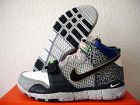The Importance Of Right Shoes For Fitness Workouts
 Walk into any sports shoe store, and inevitably you are confronted by smarmy salesmen spouting techno-babble that goes right over your head. All you want is a pair of running shoes. What you get is a running spiel, by the end of which you would be forgiven for wondering whether you are being sold the latest version of a television. Here is a perfect guide to help you find a perfect pair of sneakers without breaking a sweat.
Walk into any sports shoe store, and inevitably you are confronted by smarmy salesmen spouting techno-babble that goes right over your head. All you want is a pair of running shoes. What you get is a running spiel, by the end of which you would be forgiven for wondering whether you are being sold the latest version of a television. Here is a perfect guide to help you find a perfect pair of sneakers without breaking a sweat.
Know Your Feet:
Your foot type plays an important role in selecting running shoes to prevent injury and rectify any bio mechanical problems like pronation and gait. To find out your particular foot structure, wet both feet and press them on to a clean piece of white paper / sand bed. Now check out which foot category yours fall into, and the ideal shoe for you.
1. Normal: Has normal-sized arches, will leave a complete footprint that flares out with forefoot and heel connected by a broadish band. It’s the most bio mechanically efficient type. Look for – stability shoes with moderate control features.
2. Flat: Leaves behind an unbroken band from forefoot to heel. Because the arches are abnormally flattened out the entire foot makes contact with the ground. Flat footers are typically overpronators, i.e. the feet strike on the outside of the heels and rolls inwards (pronates) excessively. It is a common foot problem. Look for – extra cushioning, medial support and specially designed insoles.
3. High Arches: These leave an imprint showing a very narrow band or none at all, connecting the forefoot and heel. High arches are usually supinated and not effective shock absorbers. They are prone to overuse injuries. Look for – shoes that are flexible and has firm uppers and hell supports to keep feet in place.